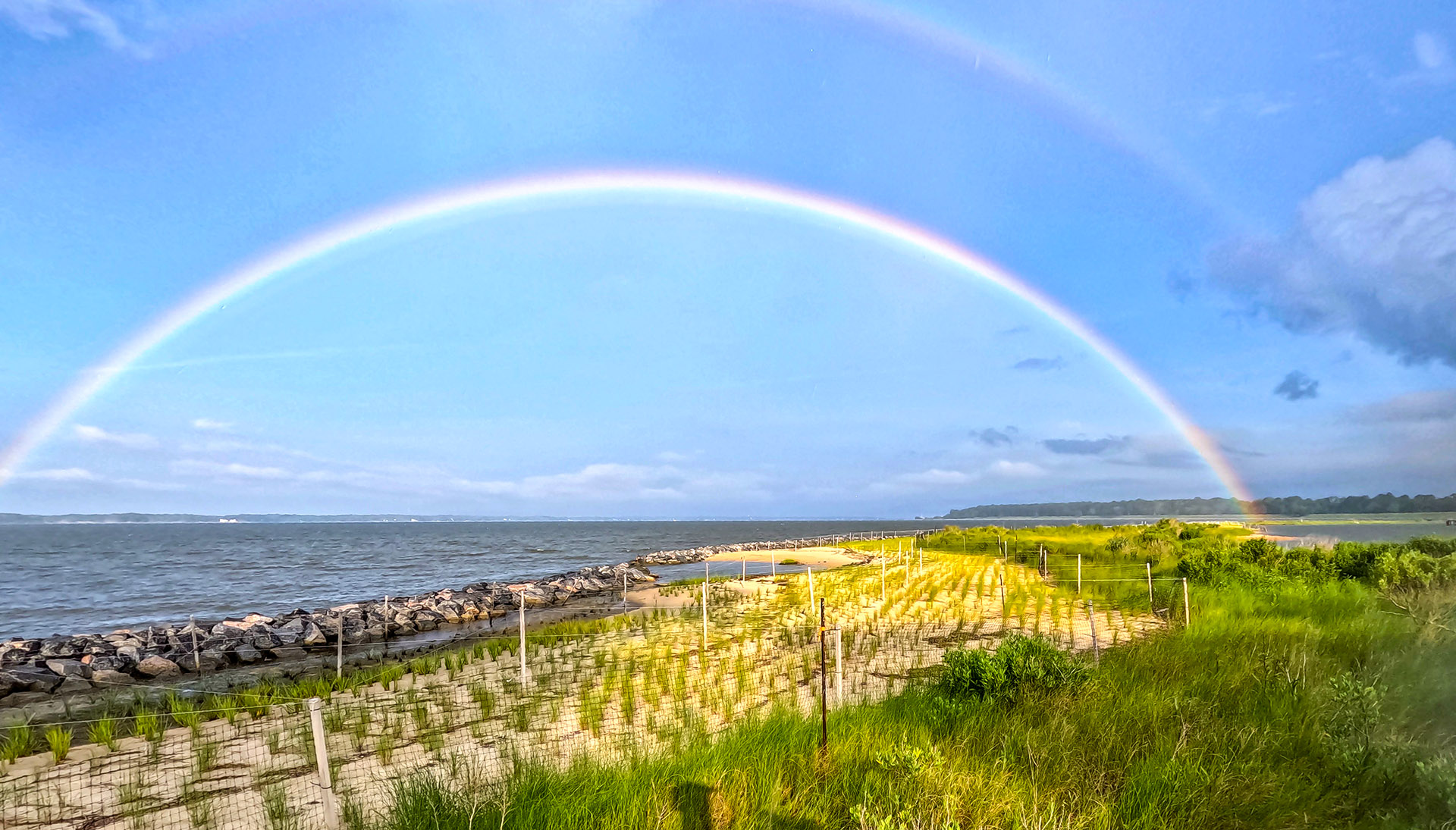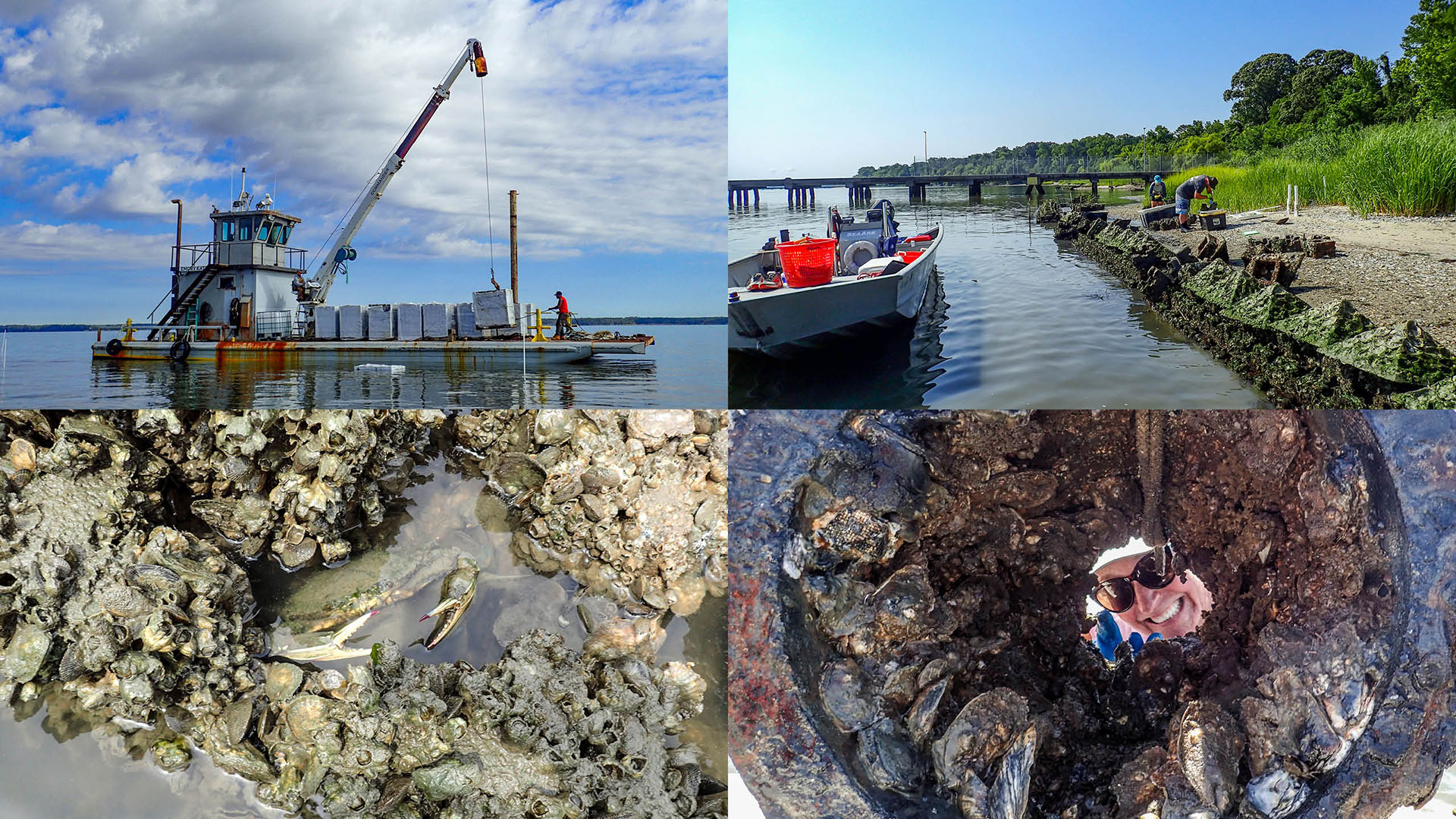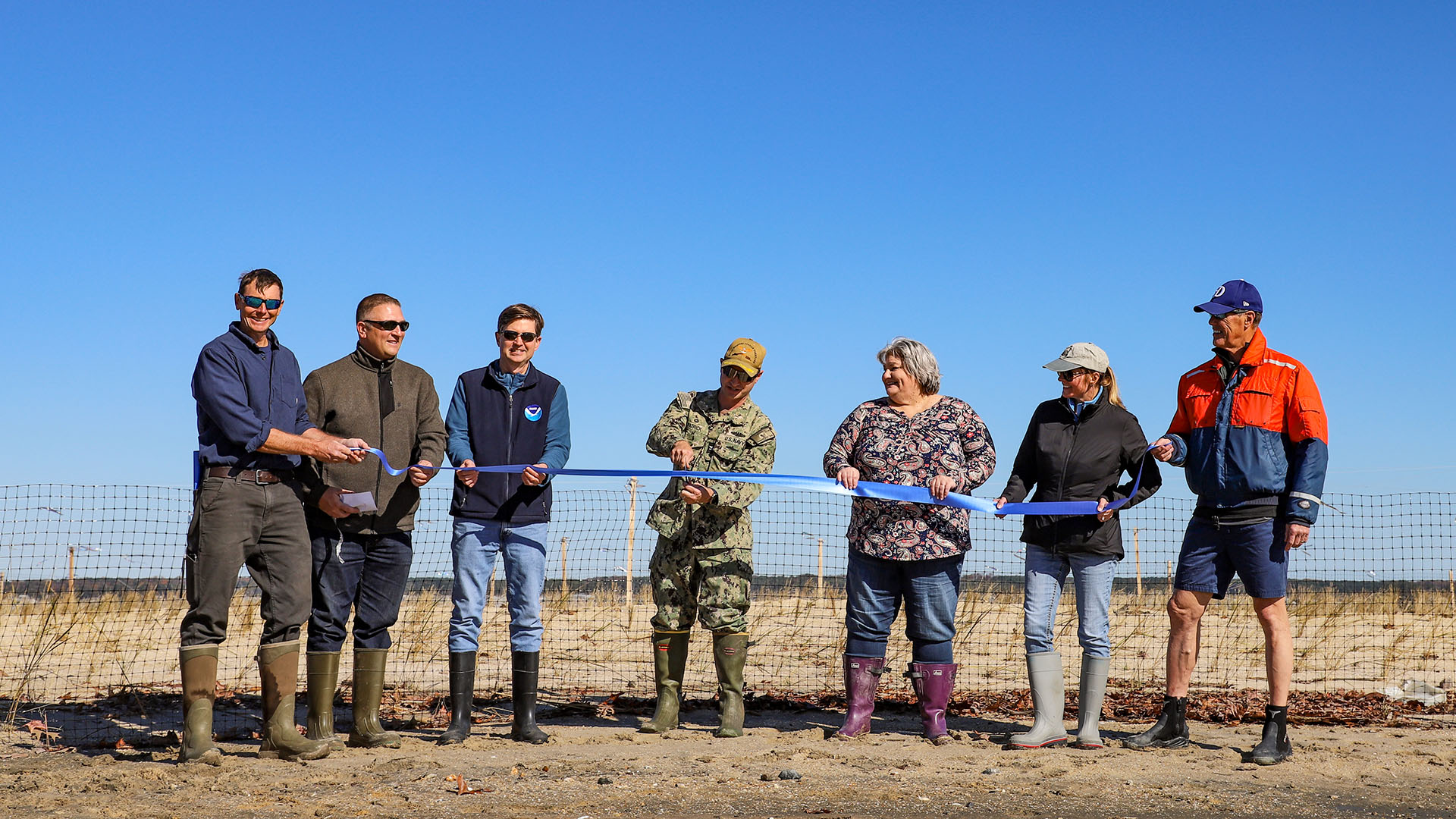Shoring up naval readiness and ecological resilience
A multi-million-dollar project involving Naval Weapons Station Yorktown brought together a team of scientists to develop solutions that protect the base while benefiting the environment.
 Anyone familiar with the horseshoe-shaped beaches at historic Yorktown, Virginia, has seen examples of William & Mary’s Batten School & VIMS’ expertise in resilient shoreline planning and design. But allow your eyes to follow one of the many Navy vessels that pass under the Coleman Bridge and you will find a much larger project that supports military readiness while paying ecological dividends for the entire region.
Anyone familiar with the horseshoe-shaped beaches at historic Yorktown, Virginia, has seen examples of William & Mary’s Batten School & VIMS’ expertise in resilient shoreline planning and design. But allow your eyes to follow one of the many Navy vessels that pass under the Coleman Bridge and you will find a much larger project that supports military readiness while paying ecological dividends for the entire region.
The genesis of what eventually became a multi-institutional, $4.5 million project funded through the Department of Defense (DoD) Readiness and Environmental Protection Integration (REPI) Program was a simple observation shared by Rom Lipcius and Rochelle Seitz nearly a decade ago during their morning commutes along the Colonial Parkway.
“Every morning, I would drive past the Naval base and look at their expansive pier system. I thought, ‘this would be a perfect spot for an oyster sanctuary,’” remembered Lipcius.
Lipcius reached out to Naval Weapons Station Yorktown (NWSY) Natural Resources Manager Tom Olexa with this idea. However, while Olexa was eager to assist with Lipcius’ ecological goal, he had a larger concern: the eroding shoreline surrounding the R3 Pier and the base as a whole.
Lipcius and Seitz tapped into expertise from Scott Hardaway and Donna Milligan with the Batten School & VIMS’ Shoreline Studies Program, as well as Russell Burke Ph.D. ’10, a senior lecturer at Christopher Newport University (CNU) who specializes in installing artificial oyster reefs for shoreline protection. The group received grants from the Chesapeake Bay Trust and the Chesapeake Research Consortium to facilitate initial designs and permits, and the work was championed by partners at the Pew Charitable Trusts.
The momentum ultimately led to a landmark project with two major components: the restoration of Penniman Spit, a marsh-fringed spit at the edge of the base that had split in two and was in danger of eroding into the York River, and the installation of intertidal and subtidal oyster reefs at the NWSY’s R3 Pier and along Penniman Spit. These efforts complemented work by the National Park Service on the Colonial Parkway to strengthen the shoreline around the base, provided important environmental benefits to the surrounding region and contributed to the Chesapeake Bay’s oyster restoration goals.
Protecting infrastructure, ensuring readiness
 The DoD’s REPI Program supports military readiness by facilitating partnerships that protect military installations while providing environmental and community benefits in adjacent lands not owned by the military.
The DoD’s REPI Program supports military readiness by facilitating partnerships that protect military installations while providing environmental and community benefits in adjacent lands not owned by the military.
“Number one is protecting our R3 Pier infrastructure,” said Olexa of the sprawling pier complex at the base that serves as a critical supply line for the Navy’s Atlantic Fleet. “Anything we can do to prevent erosion along that pier directly supports military readiness.”
This part of the project was led by Lipcius, Seitz and Burke. Seitz led sampling efforts to gather an ecological baseline that could later be used to evaluate the project’s environmental impacts. Then, an array of artificial oyster reefs were deployed intertidally along the pier’s shoreline and in adjoining shallow, subtidal waters.
“We installed a variety of shallow, intertidal reefs that are designed to not only dissipate the wave energy eroding the shore, but also trap and accrete sediment in a way that promotes shoreline stability. The subtidal reefs located further offshore are designed primarily for oyster recruitment,” said Burke, who earned his Ph.D. at the Batten School & VIMS and holds two decades of experience designing these forms of living breakwaters. “These artificial reef structures were installed extensively around the R3 Pier, and they were also a prominent feature in the Penniman Spit design.”
For Seitz, the reefs are about more than oysters. “Oyster reefs aren’t just about a single species. Like coral reefs, they create entire ecosystems. Mud crabs, blue crabs, fish — all of them find refuge there. Our monitoring shows these reefs boost biodiversity and secondary production across the food web.”
The team was also supported by hydrodynamic modeling that confirmed the location’s potential benefits as an oyster sanctuary. “Our models showed that larvae produced at these reefs will drift toward commercial harvest grounds, while a portion get returned to help sustain the reefs themselves,” said Lipcius. “It’s like a savings account for oyster restoration.”
Rebuilding a vanishing landmark
 Once stretching more than 14 acres into the York River, decades of storms and tidal energy had carved a channel in the middle of Penniman Spit and whittled the land mass down to less than two acres by 2019. Without its protection, the unique ecosystem that exists in Kings Creek along with the shoreline around the base were at risk.
Once stretching more than 14 acres into the York River, decades of storms and tidal energy had carved a channel in the middle of Penniman Spit and whittled the land mass down to less than two acres by 2019. Without its protection, the unique ecosystem that exists in Kings Creek along with the shoreline around the base were at risk.
“Penniman Spit was disappearing before our eyes,” said Donna Milligan with the Batten School & VIMS’ Shoreline Studies Program. “Once that piece of land is gone, not only would the shoreline around the base be subject to increased erosion, all of the sediment behind it as well as the ecosystem it supports would get swept into the York River.”
Milligan and her colleague Scott Hardaway designed and installed what they refer to as a hybrid living shoreline. Crews strategically placed rock sills in front of the spit to absorb wave energy, barged in more than 24,000 tons of sand and planted over 90,000 native marsh grasses. The result: 2.25 acres of new marsh, protection for nearly five acres of existing marsh and stabilized almost 2,000 feet of shoreline.
“It’s cheaper to build a rock wall, but you don’t get the ecosystem services,” said Hardaway. “A hybrid design creates habitat as well as protection. Shellfish, particularly oysters, grow well on the rocks. Even the gaps between boulders matter – they provide refuge for animals like crabs and juvenile fish while the rocks act to shield the vegetation behind them.”
Milligan and Hardaway have extensive experience in these types of designs, having worked for decades with local municipalities around Virginia’s coast. “Our work is designed for permanence and protection. That’s what differentiates it from smaller-scale erosion control projects in lower-energy environments. When you’re facing Nor’easters and hurricane-driven surge, you need something that truly holds,” said Milligan.
The restoration of the spit not only rebuilt a natural shield but also will revive the spit’s role as a training and recreation site for the Navy. By far the largest and most expensive component of the REPI project, the effort earned the Virginia Governor’s Environmental Excellence Award for its scope and innovation.
Science that lasts
 For Olexa, the project showcases the Navy’s dual role as both a defender of national security and a steward of the environment. “Even though we may not own the nearshore waters, we operate and train in the York River and have a responsibility not to impact these resources negatively,” he said, while crediting the Batten School & VIMS with making the effort possible. “Having that level of expertise in design and implementation was key. VIMS was not only a project sponsor, they helped from design to permitting to awarding the construction contract. Ultimately, this work will preserve critical operational assets, infrastructure, land and capabilities at and around Naval Weapons Station Yorktown.”
For Olexa, the project showcases the Navy’s dual role as both a defender of national security and a steward of the environment. “Even though we may not own the nearshore waters, we operate and train in the York River and have a responsibility not to impact these resources negatively,” he said, while crediting the Batten School & VIMS with making the effort possible. “Having that level of expertise in design and implementation was key. VIMS was not only a project sponsor, they helped from design to permitting to awarding the construction contract. Ultimately, this work will preserve critical operational assets, infrastructure, land and capabilities at and around Naval Weapons Station Yorktown.”
However, the work doesn’t end with construction. Penniman Spit as well as the shoreline surrounding the R3 Pier will be monitored to assess overall protection and resilience. In addition, Seitz, Burke and Lipcius, with assistance from students at the Batten School & VIMS and CNU, will measure changes in productivity, biodiversity and sediment accretion resulting from the project. “We can actually put a number on it—how many times more productive the reef becomes compared to what was there before,” Seitz explained.
That rigor ensures funders and partners have evidence of the project’s benefits in terms of protecting base infrastructure and ecological impacts, setting a standard for future restoration efforts in the region.
For Lipcius, the project’s success is personal as well as professional. “It was a dream come true,” he said. “To achieve an ecological goal like oyster restoration while rebuilding Penniman Spit and partnering with the military – it was more than I ever imagined.”

